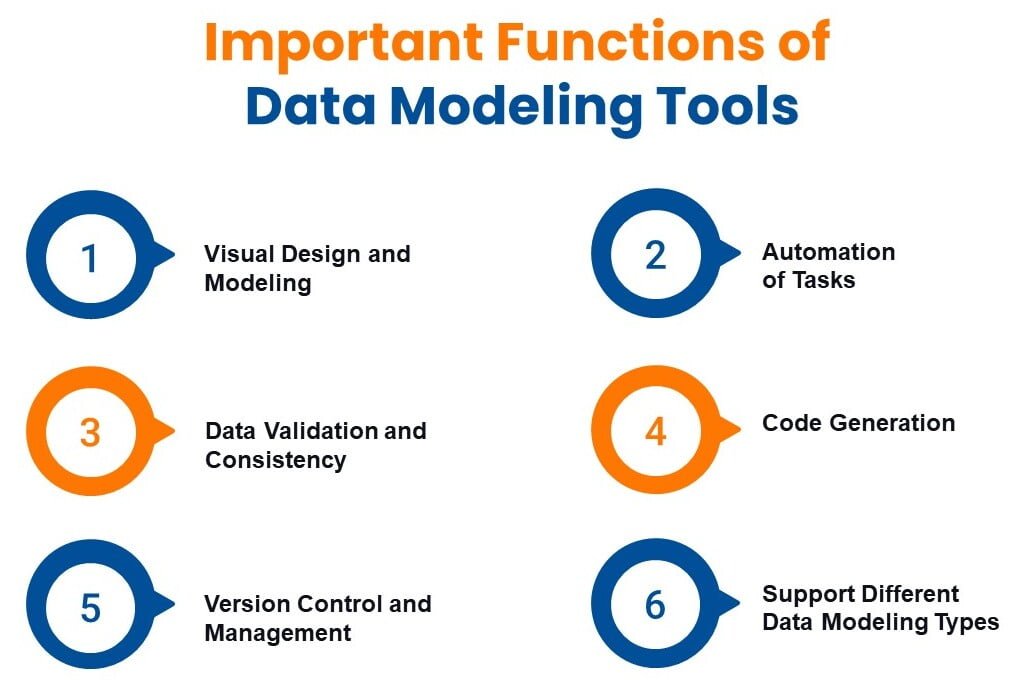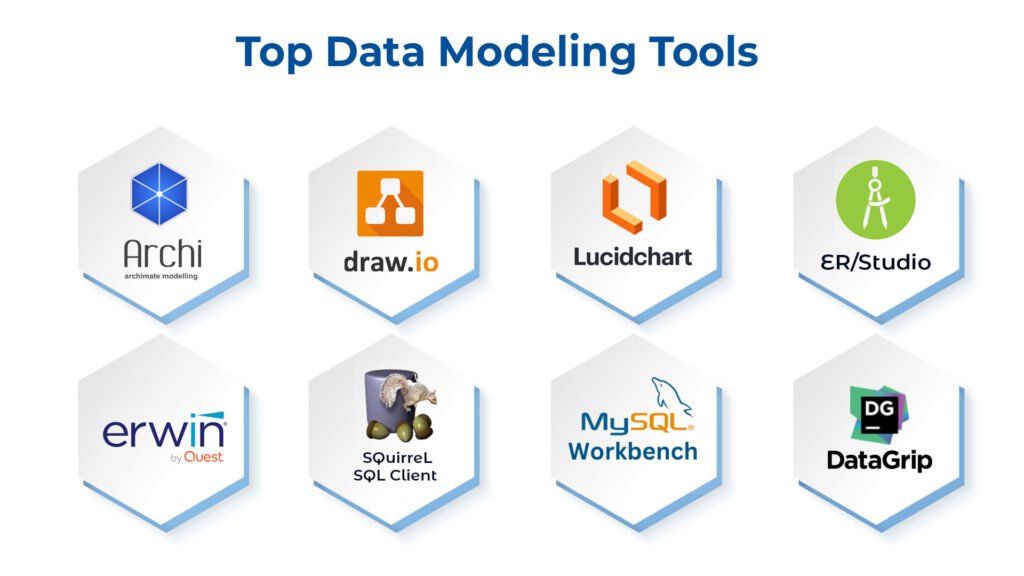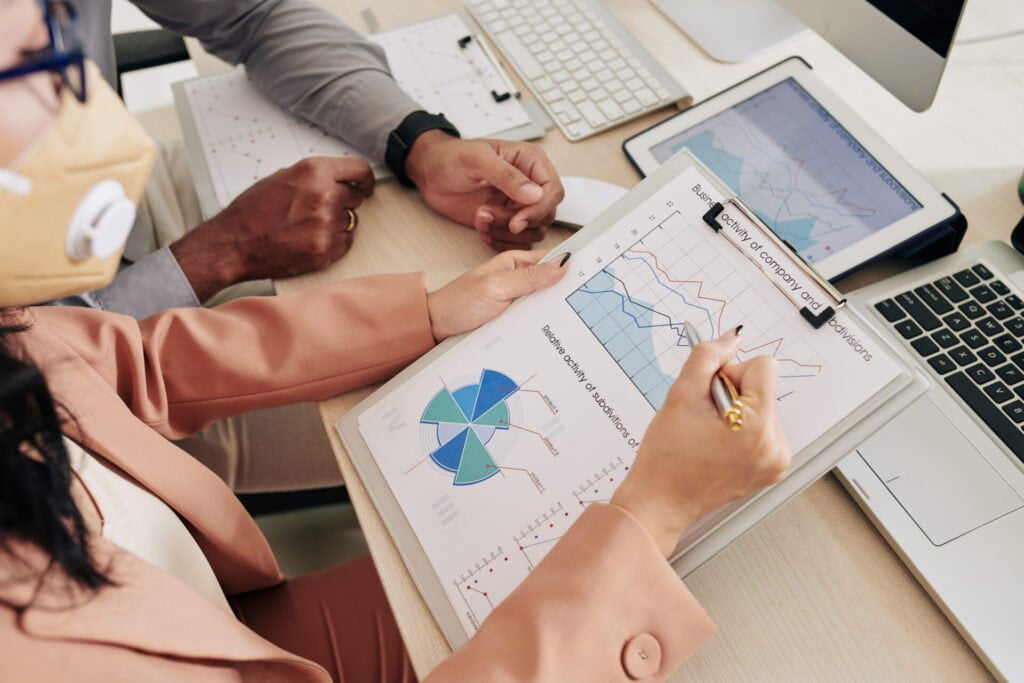Data is the lifeblood of businesses today, but how effectively businesses are utilizing this data is a million-dollar question. Recent studies show that data scientists spend over 80% of their time tackling unruly data, while more than 50% of data professionals’ time is wasted due to poor-quality data. Data modeling is a technique that helps address these data challenges, fueling smarter decisions and skyrocketing business performance. The tools that facilitate data modeling are called data modeling tools.
Effective data modeling has become a necessity in the modern business landscape. By organizing and structuring information meaningfully, organizations can unlock the true potential of their data, fostering deeper insights and informed decision-making. However, with the constant evolution of data volume and complexity, choosing the right data modeling tools can be a daunting task. In this blog, we will discuss the eight of the most powerful data modeling tools available today and how efficiently they help businesses solve their data problems.
Table of Contents
- What is Data Modeling?
- 6 Commonly Used Data Modeling Types
- What Are Data Modeling Tools?
- Key Functionalities of Data Modeling Tools
- Top 8 Data Modeling Tools That Can Solve Your Data Problems
- What is the Business Impact of Data Modeling Tools?
- Applications of Data Modeling Tools
- Case Studies: How Kanerika’s Data Management Solutions Empowered Businesses
- Trust Kanerika for Superior Data Management Services
- FAQs
What is Data Modeling?
Data modeling is the foundational process of structuring information within an organization. It defines and organizes data to facilitate efficient storage, retrieval, and analysis. Imagine it as the blueprint for a building. Just like an architect defines the layout and relationships between rooms, data modeling establishes how data elements (like customer names, product details, or sales figures) are organized, connected, and stored. This clear structure empowers businesses to analyze their data efficiently, extract valuable insights, and make data-driven decisions.
6 Commonly Used Data Modeling Types
While there are several types of data modeling available, the six most popular and commonly used ones are – conceptual, logical, physical, dimensional, object-oriented, and hierarchical models.
1. Conceptual Data Models
High-level data representations that identify entities, attributes, and relationships within an organization are called conceptual data models. They provide a broader view of the data structure and do not depend on any technology. Examples of conceptual data models include ER modeling and Object-oriented data models.
2. Logical Data Models
Logical data models are crucial when it comes to database performance. They define data types for attributes and provide a comprehensive overview of the data, including all entities, attributes, relationships, and primary and foreign keys. These models define the data storage structure in a database, accounting for the particular technology being used and performance demands, thereby guaranteeing effective data storage.

3. Physical Data Models
Physical data models are the most comprehensive, designed for a particular database management system (DBMS). They include every table, column, relationship, index, trigger, and stored procedure. They outline the format in which information will be stored in a database, taking into account the technology being utilized and the performance demands. Distributional-relational databases and the JC3IEDM are two common examples of physical data models.
4. Dimensional Data Models
Dimensional data models are used to support data warehousing and business intelligence applications. They are designed to optimize query performance and data retrieval and are often used in data mining and predictive analytics.
5. Object-Oriented Data Models
Object-oriented data models are designed to represent data as objects with attributes and methods. They are often used in software development and application design and are particularly useful in modeling complex systems with multiple relationships and dependencies.
6. Hierarchical Data Models
A type of data model that offers a systematic and structured way to organize and retrieve data is called a hierarchical data model. It is one of the earliest data models, mostly used for hierarchically representing structured data. Data is arranged into a tree-like structure using branches that share an origin point in the hierarchical data model, which is intended to function as most data relationships are viewed.
Read More – 6 Core Data Mesh Principle for Seamless Integration
What Are Data Modeling Tools?
Data modeling tools are specialized software applications designed to streamline and enhance the process of creating and manipulating data models. They function like digital architects, assisting users in visually representing, defining, and structuring information within a database. These tools offer a range of functionalities that can significantly improve data modeling efficiency.
Key Functionalities of Data Modeling Tools
1. Visual Design and Modeling
This is the heart of most data modeling tools. They offer intuitive interfaces for creating Entity-Relationship Diagrams (ERDs) and other visual representations of data models. These visuals simplify data model creation and enhance communication and understanding for both technical and non-technical users.
2. Automation of Tasks
Data modeling tools are champions of efficiency. They automate repetitive tasks like data type definition, foreign key generation, and schema creation. This frees up valuable time for data modelers to focus on the bigger picture – designing a robust and optimized data architecture. Additionally, automation reduces the risk of errors that can creep in during manual data entry.
3. Data Validation and Consistency
Data integrity is paramount. Many data modeling tools integrate data validation checks to identify and address inconsistencies within the model. These checks can ensure data types are consistent, relationships are defined accurately, and the overall model adheres to predefined business rules.

4. Code Generation
Advanced data modeling tools offer developers and database administrators a significant time saver. They can automatically generate code (e.g., SQL scripts) directly from the data model. This eliminates the need for manual code writing, reduces the risk of errors during translation, and expedites database creation and deployment.
5. Support for Different Data Modeling Types
Effective data modeling tools provide flexibility. They should support various data modeling types, including relational, dimensional, and Entity-Relationship models. This allows users to choose the approach that best suits the specific data structure and analysis needs of their project.
6. Version Control and Management
Data models are living documents that evolve over time. Data modeling tools often offer version control functionalities, allowing users to track changes, revert to previous versions, and collaborate effectively on model updates.
Top 8 Data Modeling Tools That Can Solve Your Data Problems
1. Archi
Archi is an open-source data modeling tool used globally by various industries. It offers a low-cost solution for users starting their journey in the ArchiMate modeling language.
Key Features
- A cross-platform ArchiMate modeling tool
- Ability to explore tables saved in a database
- ER diagram generation
Use Cases
- Enterprise architecture planning
- Document IT infrastructure and relationships with business processes
- Compliance with ArchiMate standards
2. Draw.io
This is a free, intuitive, browser-based flowchart builder that allows users to drag and drop entity shapes and join them with connector lines. Draw,io is useful for quickly creating diagrams, especially for structured data like finance models.
Key Features
- An SQL plugin
- Ability to draw ER diagrams
- Reverse engineering of existing databases
Use Cases
- Create quick data flow diagrams and ERDs
- Simple data modeling for small projects
- Collaborative diagramming for non-technical users
3. Lucidchart
This is a web-based diagramming software that allows users to create and share diagrams, charts, and flowcharts. Lucidchart integrates various tools and platforms, making it a versatile choice for data modeling.
Key Features
- User-friendly drag-and-drop interface for diagramming
- A vast library of templates and symbols for data modeling
- Cloud-based with real-time collaboration
Use Cases
- Create professional-looking ERDs and data flow diagrams
- Collaborative data modeling for teams
- Documenting database schemas for developers
4. SQuirreL SQL Client
This data modeling tool is a graphical SQL client that allows users to manage and manipulate databases. SQuirreL SQL Client offers a Java-based interface that supports various databases, making it a flexible choice for data modeling.
Key Features
- SQL query execution
- Database metadata browsing
- Data export options
Use Cases
- Managing and querying databases
- Exploring existing database structures
- Visualizing database schemas

5. MySQL Workbench
It is a free, open-source, and cross-platform data modeling tool for MySQL databases. MySQL Workbench offers an intuitive interface for data modeling, SQL development, and database administration.
Key Features
- User-friendly interface for designing relational databases
- Supports visual ERD creation
- Built-in SQL editor for querying databases
Use Cases
- Relational database design and modeling
- Creating and modifying database structures
- Generating SQL code from ER diagrams
6. erwin Data Modeler
This is an industry-leading data modeling tool that offers a wide range of use cases for data architects, DBAs, and data modelers across various stages of the database development process.
Key Features
- Robust functionality for complex data models
- supports various data modeling types
- data profiling and analysis capabilities
Use Cases
- Complex data warehouse design
- Data migration and integration planning
- Regulatory compliance reporting.

7. ER/Studio
It is a data modeling tool that offers a comprehensive solution for data modeling, design, and documentation. ER/Studio supports various data types and platforms, making it a versatile choice for data modeling.
Key Features
- Visual data lineage mapping
- Data quality management
- Version control for data models
Use Cases
- Handle complex data modeling projects
- Data warehousing and business intelligence initiatives
- Data flow visualization
8. Datagrip
This is a database management tool offering a comprehensive database administration, querying, and development solution. Datagrip supports various databases, making it a flexible choice for data modeling.
Key Features
- Supports various database platforms
- Visual database schema browsing,
- Powerful SQL editor with code completion and refactoring
Use Cases
- Database development and administration
- Writing and debugging complex SQL queries
- Managing and exploring database structures
What is the Business Impact of Data Modeling Tools?
In today’s data-driven world, effective data management is no longer a luxury; it’s a necessity. Data modeling tools are critical in this process, offering many benefits that can significantly impact your business. Here are seven key advantages of leveraging data modeling tools:
1. Enhanced Data Quality and Consistency
Data integrity is safeguarded by data modeling tools. They detect errors, implement data validation policies, and ensure that data elements are defined and stored consistently throughout the model. Cleaner and more reliable data will make analysis more precise and, ultimately, lead to improved decision-making.
2. Improved Data Governance and Compliance
Data governance projects can be expedited with the use of data modeling technologies. Role-based access control and audit trails are two features that guarantee data security and regulatory compliance. Data models also make team communication easier and data governance policy adherence simpler with their explicit documentation.
5. Increased Efficiency and Productivity
Data modeling tools eliminate repetitive tasks. Data analysts and modelers can now spend more time analyzing and creating data since automation capabilities like data type definition, foreign key generation, and schema building greatly reduce manual labor. They can now concentrate on more strategic duties like model optimization and data analysis as a result.

4. Better Collaboration and Communication
They can bridge the gap between technical and non-technical stakeholders. Data structures and relationships can be clearly communicated with the help of visual representations such as ER diagrams. Features that promote collaboration, such as version control and shared workspaces, make sure that everyone is in agreement, and speed up the data modeling process.
5. Faster Time-to-insight
These tools help in quickly converting from raw data to actionable insights. By simplifying data organization and enabling efficient querying, these tools empower users to explore data faster, uncover hidden patterns, and generate valuable insights sooner. This faster access to insights allows businesses to make data-driven decisions and react quickly to market changes.
6. Reduced Costs and Improved ROI
Data modeling tools lead to cost reductions through increased efficiency and better data quality. Your data initiatives will yield a higher return on investment (ROI) by cutting down on the amount of time spent on manual operations, minimizing errors, and enhancing data governance.
7. Scalability and Flexibility
These tools are designed to grow and evolve with your company’s demands. The scalability of these tools allows you to adapt to changing data volumes and complexity, whether you’re working with small datasets or handling huge data. This future-proofs your data infrastructure and ensures you can continue to leverage the power of data modeling as your business expands.
Applications of Data Modeling Tools
Applications of data modeling tools in various industries include:
1. Financial Services
In financial services companies, data modeling tools are mostly used to design and manage data structures for financial transactions, customer data, and risk management. They help ensure data accuracy, consistency, and integrity, enabling financial institutions to make informed decisions and comply with regulatory requirements.
2. Healthcare
In healthcare, these tools are used to create and maintain data structures for clinical trials, medical research, and patient records. They provide data integrity, precision, and consistency, which enables healthcare companies to successfully carry out research and deliver high-quality care.
3. Retail
Data modeling tools are essential for certain key operations in the retail industry. They can help design and maintain data structures for sales transactions, product catalogs, and customer information. Retailers may enhance sales performance, optimize inventory management, and personalize consumer experiences by utilizing their assistance in ensuring data quality, consistency, and integrity.
4. Manufacturing
Production scheduling, quality assurance, and supply chain management can all be designed and managed with the use of data modeling tools. They provide data integrity, precision, and consistency, which helps manufacturers cut expenses, streamline operations, and produce higher-quality products.
5. Telecommunications
In the telecom sector, these data modeling tools are used to create and maintain data structures for network architecture, delivery of services, and consumer data. By assisting in maintaining data integrity, accuracy, and consistency, they enable telecom firms to enhance service delivery, personalize consumer experiences, and maximize network performance.
6. Technology
Data modeling tools can generate and manage data structures for cloud computing, data warehousing, and software development. By helping maintain data integrity, correctness, and consistency, they enable tech companies to function at their best in these fields.
7. E-commerce
In the E-commerce industry, data modeling tools are crucial for e-commerce companies to manage product catalogs, analyze website traffic, and personalize the consumer experience. They assist in optimizing website layouts for greater user engagement, modeling consumer interactions, and making product recommendations based on browsing behavior.
8. Media and Entertainment
Data modeling tools are employed by the media and entertainment sector to gain insight into audience preferences, customize content recommendations, and enhance advertising efforts. These tools support popular trend prediction, audience engagement with content tracking, and sentiment analysis on social media.
Case Studies: How Kanerika’s Data Management Solutions Empowered Businesses
Case 1: Transforming Data Management and Analytics with Power BI
Client’s Business Challenges
- Faced data fragmentation across systems like MS Dynamics ERP and SQL Server, impairing analytics and decisions.
- Insufficient real-time analytics slowed response to operational issues, resulting in missed opportunities and revenue loss.
- Absence of a consolidated data view impeded strategic decisions, restricting competitive edge and growth.
Our Solutions
- Streamlined disparate data sources into a unified platform, enhancing data accuracy and decision-making efficiency.
- Deployed dynamic, real-time Power BI dashboards for instant operational adjustments and strategic actions.
- Developed custom Power BI reports and dashboards, enhancing processes and performance with deep insights.
Case 2: Revolutionizing Data Management Services for Enhanced Security
Client’s Business Challenges
- Outdated legacy system causing compatibility, security, and efficiency issues.
- Difficulty in managing and transferring large volumes of files and data, impacting process efficiency and business agility.
- Risks associated with outdated technology, including security, compliance, and safety concerns.
Our solutions
- Implemented Informatica MFT and IICS for a modernized UX, seamless application integration (CRM & Data).
- Incorporated automation and third-party integrations for efficient file transfer monitoring, optimizing business operations.
- Achieved enhanced data security, minimized manual effort, and improved cost efficiency with Informatica MFT and IICS.

Trust Kanerika for Superior Data Management Services
As a globally recognized technology consulting firm, Kanerika offers exceptional data management solutions by leveraging advanced data analytics, modeling, and visualization tools and techniques to resolve your data problems, enhance your operations, and save time and expenses. We have a proven track record of providing innovative and effective data management solutions for many major enterprises across the globe.
We are a proud consulting partner for leading companies like Microsoft, Amazon AWS services, UiPath, and Informatica. Using industry-leading tools and techniques, we ensure your data is accurate, consistent, and accessible, enabling you to make informed decisions and drive business growth. With Kanerika, you can trust that your data is in safe hands, and you will receive personalized attention and support to meet your unique business needs. Contact us today to learn more about our data management services and how we can help you achieve your business goals.


















